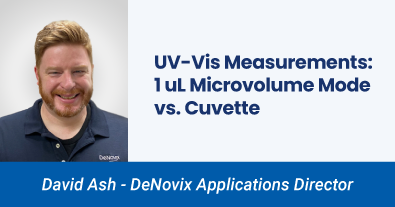Written by David Ash, DeNovix Applications Director
Beer’s Law (also known as the Beer-Lambert Law) establishes that the absorption of light by a sample is directly proportional to both the concentration of the absorbing species and the pathlength the light travels through the sample. Pathlength refers to the distance the light travels while passing through the sample and is typically set by a container like a cuvette or the defined gap between two surfaces in microvolume measurements.
In microvolume mode, such as that used in the DeNovix DS-Series Spectrophotometers, surface tension holds a 1 µL droplet in place between two optical surfaces. To learn more about this concept, see our technical note on Beer’s Law.
So how do you choose if microvolume UV-Vis measurement is right for your sample?
Choosing Between Microvolume and Cuvette UV-Vis Measurements
Selecting between microvolume and cuvette modes depends on several factors:
- Sample type: Is it a DNA sample, protein, or another material?
- Sample solvent: What is the solvent used (e.g., water, organic solvent)?
- Sample concentration: Are high concentrations expected, or is the sample near the limit of detection?
- Available volume: How much of the sample can be used for analysis?
When to Use Microvolume
Microvolume UV-Vis measurements have become the standard for nucleic acid quantitation and protein analysis, particularly when working with small volumes and high concentrations. Common workflows, such as spin column mini preps, yield DNA concentrations that fall comfortably within the dynamic range of microvolume spectrophotometers (e.g., 0.75 ng/µL to 37,500 ng/µL for dsDNA on DS-Series instruments).
Key Benefits:
- Sample conservation: Requires only 1 µL, preserving the rest for downstream applications.
- No dilution required: Eliminates errors from serial dilutions and pipetting inconsistencies.
- Automatic pathlength selection: Technologies like SmartPath™ optimize the path length automatically.
- Simple cleanup: A quick wipe removes the sample, reducing risk of contamination.
Microvolume mode is especially advantageous for measuring water-based solutions that maintain integrity due to surface tension and evaporate slowly, supporting accurate quantitation.
If your sample volume is limited or you’re conducting routine DNA quantitation, microvolume UV-Vis is typically the preferred choice.
When Should Cuvettes be Used?
While microvolume measurements have become routine for many sample types, traditional cuvettes still have utility for some assays.
- Samples in Volatile Solvents: The cuvette, being a mostly closed vessel, slows down the evaporation of organic solvents, helping preserve sample volume and translating to greater accuracy when measuring volatile samples.
- OD600 Measurements of Microbial Samples: Users can leverage the longer 10 mm path length of cuvettes to perform accurate light scattering measurements such as OD600 assessments of bacteria or yeast samples.
- Kinetic Assays: When you need to monitor changes in absorbance over time, such as in enzyme reactions, the larger volume and controlled environment of a cuvette allow for stable, continuous measurements.
Why use Microvolume Mode for Sample Measurements?
The benefits of switching to microvolume UV-Vis measurements are numerous:
- Sample Conservation: Using only 1 uL of sample for quality control measurements preserves more sample volume for additional QC assessments as well as making more of the sample available for endpoint analysis.
- Eliminate Sample Dilution: Prior to the introduction of microvolume UV-Vis measurements, the user typically made an educated guess about the sample concentration or may prepare a few sample dilutions to ensure the absorbance falls within the linear range of the fixed pathlength. If the sample is too concentrated for the cuvette pathlength, the user will obtain inaccurate absorbance measurements. Eliminating the need for sample dilutions also reduces additional error from either pipetting the incorrect volume or not dispensing the entire volume across serially diluted samples.
- Multiple Pathlengths to Optimize any Sample: The microvolume mode on instruments like the DS-Series Spectrophotometers uses SmartPath™ technology. This automatically selects the correct pathlength for each measurement, allowing it to handle a wide range of concentrations (e.g., 0.75 ng/µL to 37,500 ng/µL for dsDNA).
- Easy Cleanup: Removing the sample is simple following a microvolume measurement— just wipe away with a clean, dry lab wipe. Cuvettes are more time-consuming to clean, requiring washing and drying to avoid contamination. Disposable cuvettes avoid this but come with a financial and environmental cost.
Conclusion
For routine nucleic acid quantitation and protein measurements, microvolume UV-Vis offers unmatched efficiency, especially when working with high concentrations and limited sample volume. Cuvette-based measurements remain indispensable for volatile solvents, OD600 readings, and kinetic assays. Choosing the right mode ultimately depends on your sample characteristics, required sensitivity, and workflow preferences.
Need help determining the best method for your lab? Our applications team is ready to assist.

David Ash
DeNovix Applications Director
Dave brings over 20 years of molecular biology experience to the DeNovix team. His molecular work began during his undergraduate career at the University of Delaware Plant and Soil Sciences department creating SAGE libraries to profile the mRNA population in Z. Mays. Dave graduated from the University of Delaware in 2000 with a BS in Plant Science. After graduation he joined the E. W. Jabs group for craniofacial research at Johns Hopkins University where he helped characterize gene expression for human rhombomere and early mandible development. Results from the libraries he co-developed were published on the Craniofacial and Oral Gene Expression Network (COGENE) as searchable sequence tag databases. In addition to gene expression profiling, Dave was involved in mutation screening of genes suspected to be involved craniofacial disease. He joined NanoDrop Technologies as an Applications Scientist in 2004. He joined the DeNovix team in January of 2012. Dave graduated from Johns Hopkins University in May of 2004 with an MS in Biotechnology.
Speak to a DeNovix Scientist
Have an application question, or want to learn more about our products? Click the button below to schedule a call with our team of expert application scientists!



